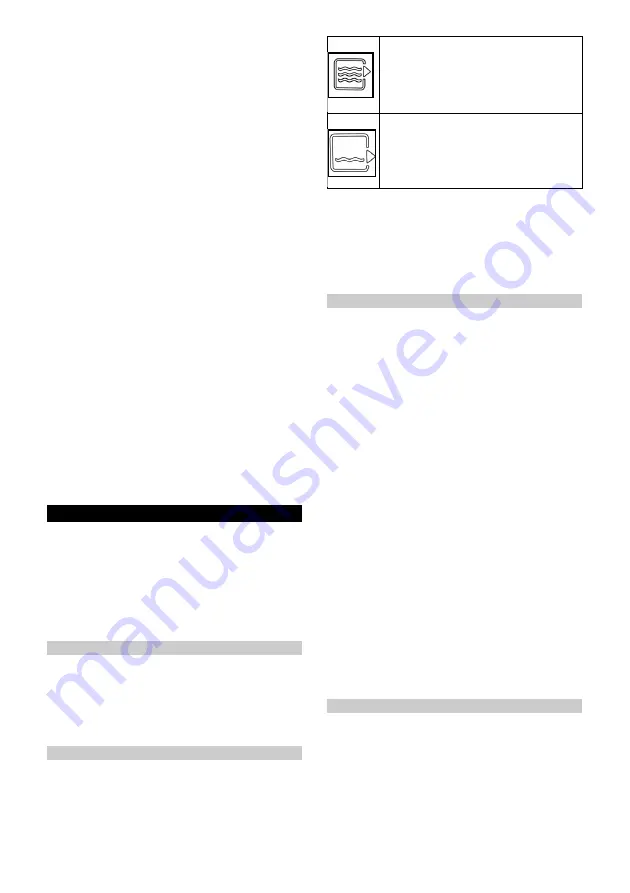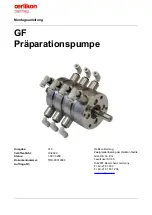
English
11
1 Screw the G 1 ½ pump connecting piece onto the
connection nozzle.
Illustration B
2 Push the hose clamp onto the hose.
3 Push the hose onto the G 1 ½ pump connecting
piece and fasten it with a hose clamp.
4 Push the connection nozzle into the Quick-Connect.
Illustration C
Connecting a hose to the pump when using a ¾
″
or
1
″
hose:
1 Screw the G 1 threaded connection onto the con-
nection nozzle.
Illustration B
2 Fit the special accessory G 1 pump connecting
piece(6.997-359.0 pump connecting piece G 1
(33.3 mm) incl. check valve - not included in the
scope of delivery) onto the G 1 threaded connec-
tion:
a Place the check valve on the G 1 threaded con-
nection so that the lettering "UP" is legible.
b Screw the pump connecting piece G 1 onto the
G 1 threaded connection.
3 Push the hose clamp onto the hose.
4 Push the hose onto the pump connecting piece G 1
and fasten it with a hose clamp.
5 Push the connection nozzle into the Quick-Connect.
Illustration C
Erecting/immersing the pump:
1 Insert the height adjustment of the float switch into
the lock.
Illustration D
2 Place the pump securely on solid ground in the
pumped liquid or immerse it via a rope attached to
the carrying handle.
Note
The suction area must not be blocked by soiling. If the
ground is muddy, place the pump on a brick or similar.
Make sure that the pump stands level. Do not carry the
pump using the cable or hose.
Operation
DANGER
Danger of death from electric shock.
Danger of death from electric shock if live parts are
touched.
During operation, do not touch the rope attached to the
carrying handle or any objects that are in contact with
the pumped liquid (e.g. pipelines protruding into the
pumped liquid, railings) and do not reach into the
pumped liquid.
Automatic venting device
1. If the fluid level is low, any sucked-in air, or air pres-
ent in the pump, may escape via the automatic vent-
ing device. Liquid can also leak along with air.
If the pump has problems priming when the fluid lev-
el is low, unplug and plug in the mains plug repeat-
edly to assist the priming process.
Illustration E
Adjusting the filter basket
The filter basket can be operated in 2 positions.
Illustration F
1. Put the pump on the ground.
2. Clamp the pump between your feet and take hold of
the carrying handle.
3. Unlatch the filter basket by turning the handle to the
right.
4. Move the filter basket into the required position.
5. Lock the filter basket in place by turning the handle
to the left
Automatic mode
1. Set the float switch using the height adjustment, and
the cable length between the float switch and the
lock.
Note
When the pump is operated unattended, always set the
float switch to the uppermost position in order to ensure
that the pump can switch off reliably.
Illustration G
When the float switch is set to the lowermost position,
set the cable length between the float switch and the
lock to 2.5 cm, see marking on the cable.
Illustration H
2. Move the filter basket into the "Waste water and
clear water delivery" position, see chapter
3. Plug the mains plug into the socket.
Note
In automatic mode, the float switch controls the pump-
ing process automatically. The pump switches on as
soon as the float switch reaches the switch-on height
caused by the rising fluid level.
The pump switches off when the float switch reaches
the switch-off height caused by the sinking fluid level.
The float switch must be able to move freely.
Note
The switching heights vary depending on:
●
Position of the float switch.
●
Cable length between the float switch and lock.
The cable length must be at least 2.5 cm. We would
recommend retaining the set cable length. For infor-
mation on the switching heights, see chapter Spec-
ifications.
Manual operation
Note
In manual operation, the pump stays switched on.
The specified residual liquid level (see chapter Specifi-
cations) can only be achieved via manual operation.
1. Fasten the float switch in the lock pointing upwards.
Illustration I
2. Move the filter basket to the desired position de-
pending on the fluid level (see chapters
).
Waste water and clear water delivery.
We would recommend this filter basket po-
sition at the start of the pumping process,
since on this occasion the pumping capaci-
ty is at its greatest.
Flat vacuuming.
In this filter basket position, flat vacuuming
is possible up to 1 mm residual fluid height
in manual operation.
Summary of Contents for SP 16.000 Dual
Page 2: ...A...
Page 3: ...B C D E F G H I...
Page 64: ...64 G 2 5 cm H 2 3 2 5 cm 1 I 2 3 1 2 3 1 2 3 Quick Connect C 4 Quick Connect 5 6 1 2...
Page 75: ...75 2 5 H 2 3 2 5 1 I 2 3 1 2 3 1 2 3 Quick Connect C 4 Quick Connect 5 6 1 2...
Page 122: ...122 1 E 2 F 1 2 3 4 5 1 G 2 5 cm H 2 3 2 5 cm 1 I 2 3 1 2 3 1 mm...
Page 123: ...123 1 2 3 Quick Connect C 4 Quick Connect 5 6 1 2 1 2 3 1 1 2 1...
Page 141: ...141 5 C 35 C REACH www kaercher com REACH www kaercher com 142 142 143 144 144 144 145 145 146...
Page 143: ...143 1 E 2 F 1 2 3 4 5 1 G 2 5 H 2 3 2 5 1 I 2 3 1 2 3 1...
Page 144: ...144 1 2 3 Quick Connect C 4 Quick Connect 5 6 1 2 1 2 3 1 1 2 1 1 1 2 3 4 5 1 2 1 2...
Page 149: ...149 2 3 2 5 1 I 2 3 1 2 3 1 2 3 C 4 5 6 1 2...
Page 150: ...150 1 2 3 1 1 2 1 1 1 2 3 4 5 1 2 1 2 1 2 1 2 3 1 2 3 4...
Page 154: ...154 1 E 2 F 1 2 3 4 5 1 G 2 5 cm H 2 3 2 5 cm 1 I 2 3 1 2 3 1 mm...
Page 155: ...155 1 2 3 C 4 5 6 1 2 1 2 3 1 1 2 1 1 1 2 3 4 5 1 2 1 2 1 2...
Page 159: ...161 1 1 2 1 1 1 2 3 4 5 1 2 1 2 1 2 1 2 3 1 2 3 4...
Page 160: ...160 1 G 2 5 H 2 3 2 5 1 I 2 3 1 2 3 1 2 3 C 4 5 6 1 2 1 2 3...
Page 163: ......












































